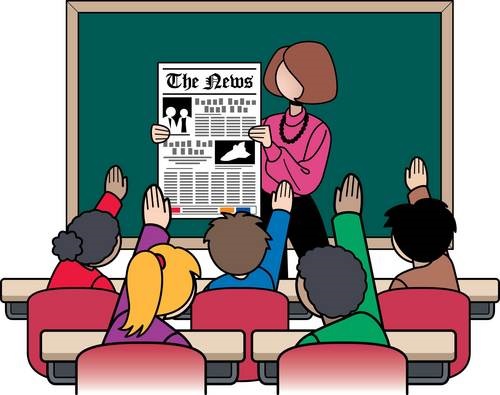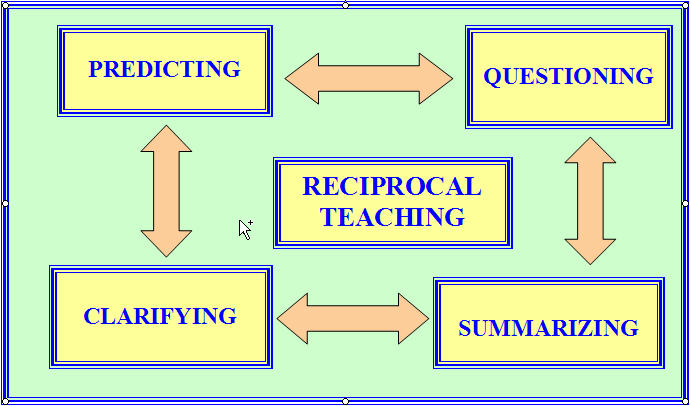Reading to Learn
Scenario A
Setting: Classroom in Hong Kong

Figure 1. Classroom in Hong Kong.Source: http://jillmackellar.files.wordpress.com/2012/08/cartoon-classroom.jpg
These teachers perception of reading is that it can be done independently. Lets see how these teachers(Ts) talk to students at classrooms.
Ts A: After reading the passage and listening to my explanation, you go home and answer these questions in the worksheet that distributed to you just now.
Ts B: The more you read, the more knowledge you get
Ts C: After reading each book, you need to submit a reading report to me as homework.
What do you think about this way to teach reading? Will it be helpful for students? What strategies does reading to learn involve?
Scenario B
One main goal of School A this academic year is to help their primary school students to become good readers. All teachers need to encourage students to read as much as they can. Students are required to read one book every week and sometimes they answer short questions about the book or write a report. The school even set up a competition scheme to award students who read most books. Many students start recording the number of books they read to move up the chart to get the stars. But Miss Wong who teaches this class also notices that there are children who cannot read well and they do not know much how to deal with a book. After all they are not too interested in school work and often they just do not submit the book report or copy the answers of short questions from their friends. Reading is not much fun to them and they think it is just another chore. How can we help the teachers and students? How can reading to learn help?
Scenario C
Miss Lau is a very well experienced Chinese Language teacher and she adopts the use of reading strategies to help students in making deeper meaning of the text passage. . She is easy going and relationship with students is excellent. The classroom atmosphere is warm and students are encouraged to voice their views; dialogue between teacher and students is always elicited.

Figure 2. Book. Source: http://katherinemcknight.com/images/book.jpg
Miss Lau attended some workshops and she started practicing some strategies that can help students to be self-regulated readers; they do not need to rely on teachers to ask them questionsor just to fill in the worksheets. With some practices, she help students and they become more or less skillful in questioning. Apart from that, they are asked to summarize ideas in the separate paragraphs and point out uncertainties to be left for clarification through group discussion, whole class brainstorming and further teacher student interaction. Factual questions seldom appear in Rositas designed worksheets while self reflection on the article content is the core element that prevails.
Definition
Reading to learn, includes the use of reading strategies to make meaning from the text. One of the most successful reading to learn model is called Reciprocal teaching, developed by Palincsar and Brown (1984), as an instructional approach that features “guided practice in applying simple, concrete strategies to the task of text comprehension” (Brown & Palincsar, 1989, p. 413).
Four activities were identified s that both improve comprehension and permit students to monitor their own understanding
-
Summarizing (self-review) includes stating what had happened in the text and also served as a self-test on the content.
-
Questioning is directed at determining what main idea question a teacher or test might ask about that material.
-
Clarifying is used when portions of the text were unclear and students could not adequately summarize.
-
Predicting is used when text cues signaled forthcoming information.
Reading to Learn

Figure 1. Reading to Learn. Source: http://mrbutterfield.wikispaces.com/file/view/rt2.jpg/440798848/333×200/rt2.jpg
Basic Assumptions and Principles
The teaching model of Reciprocal Teaching has been influenced by Vygotsky’s social constructivism theory.
-
A great deal of development was mediated by expert scaffolding.
-
Children first experience a particular set of cognitive activities in the presence of experts through social interactions with experts, primarily in the context of a dialogue between the teacher and the students
-
The cognitive development occurs when learners gradually come to perform these internalized functions by themselves. The focus is upon teaching students specific, concrete, comprehension-fostering strategies which they can apply to the reading of new text
Classroom Implication and Teaching Strategies
Researchers taught these four activities of self-directed summarizing, questioning, clarifying, and predicting as part of an interactive dialogue between teacher and student. A mode of instruction would:
-
ensure the students to participate at whatever level they were capable
-
enable them to witness the success of such activities
-
situate the strategies in an actual reading context where the goal of the activities would be transparent
-
allow students to take over the major thinking role and more responsibility as they becomes more experienced and capable of performing more complex aspects of the activities
Resources
Key Works
-
Rosenshine, B., & Meister, C. (1994). Reciprocal teaching: A review of the research. Review of educational research, 64(4), 479-530.
-
Brown, A. L., & Campione, J. C. (1994). Guided discovery in a community of learners. The MIT Press.
-
Palincsar, A. S., & Brown, A. L. (1986). Interactive teaching to promote independent learning from text. The Reading Teacher, 39(8), 771-777.
Successful Examples
-
Using Reciprocal Teaching Strategies to Boost Reading Comprehension
-
Summarization 6 Reciprocal Teaching Part 2
References
-
Palinscar, A. S., & Brown, A. L. (1984). Reciprocal teaching of comprehension-fostering and comprehension-monitoring activities. Cognition and instruction, 1(2), 117-175.
-
Brown, A. L., & Palincsar, A. S. (1987). Reciprocal teaching of comprehension strategies: A natural history of one program for enhancing learning. Ablex Publishing.